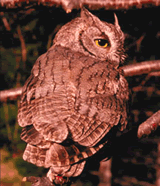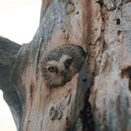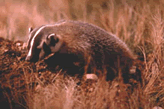|
(published
1998)
Habitat Atlas
for Wildlife at Risk
About Species at Risk
 The
Okanagan is not only noted for the diversity and uniqueness
of its plant and animal species, it is also the region
with the most endangered, threatened and rare species
in the province. The South Okanagan is home to 30 percent
of BC's Red-listed wildlife species, and 46 percent
of the province's Blue-listed species. The
Okanagan is not only noted for the diversity and uniqueness
of its plant and animal species, it is also the region
with the most endangered, threatened and rare species
in the province. The South Okanagan is home to 30 percent
of BC's Red-listed wildlife species, and 46 percent
of the province's Blue-listed species.
Endangered Species Legislation
Whether they occur on public or private,
or forest lands, wildlife, as prescribed under the Wildlife
Act of B.C., is considered a Crown resource and responsibility
of the provincial government. In the past wildlife managers
concentrated on fish and game populations. The Wildlife
Act directs the Ministry of Water, Land and Air Protection,
Lands and Parks to protect and conserve all wildlife
species in the province and the Forest Practices Code
directs District Forest Managers to protect Identified
Wildlife.
 In
1980 four species were designated as Endangered under
the Wildlife Act of British Columbia: the Vancouver
Island Marmot, Sea Otter, American White Pelican and
Burrowing Owl. No animals have been added to the list.
Once a species is designated as endangered it is at
a critical point of population decline or no longer
breeds in its former range within our province. In
1980 four species were designated as Endangered under
the Wildlife Act of British Columbia: the Vancouver
Island Marmot, Sea Otter, American White Pelican and
Burrowing Owl. No animals have been added to the list.
Once a species is designated as endangered it is at
a critical point of population decline or no longer
breeds in its former range within our province.
Wildlife managers have concluded that the most effective
way to "save" species is to conserve their
habitat and develop strategies for their protection
before they reach an endangered status. Protection for
animals that are endangered or at risk will only be
achieved through a combination of legislation, regional
conservation initiatives, public awareness, and community
stewardship.
Ranking Species at Risk
 Wildlife
managers have classified the degree to which animal
species are at risk so that they can prioritize their
conservation efforts. Each vertebrate species in the
province is ranked using a system developed over the
past 25 years by the Nature Conservancy of the United
States. Each species is ranked at two levels: global
and provincial. The global rank is based on the status
of the species throughout its entire range, whereas
the provincial rank is based on its status within British
Columbia. Wildlife
managers have classified the degree to which animal
species are at risk so that they can prioritize their
conservation efforts. Each vertebrate species in the
province is ranked using a system developed over the
past 25 years by the Nature Conservancy of the United
States. Each species is ranked at two levels: global
and provincial. The global rank is based on the status
of the species throughout its entire range, whereas
the provincial rank is based on its status within British
Columbia.
Committee on the Status of Endangered Wildlife
in Canada (COSEWIC): ranks the global status
of plants and vertebrate animals based on research and
status reports. www.speciesatrisk.gc.ca
British Columbia Conservation Data Centre (CDC):
this program within the Ministry of Water, Land and
Air Protection, Lands and Parks compiles information
on the status of provincially rare plants, plant communities,
and animals. http://www.env.gov.bc.ca/cdc/
How Is A Species Designated "At Risk"
The status of a species is indicated on a scale of
one to five; the score is based on the number of occurrences
of the species, abundance, range, protection, and threats.
- Critically imperiled because of
extreme rarity or factors making it especially vulnerable
to extirpation or extinction
- Imperiled because of rarity or
factors making it vulnerable to extirpation or extinction
- Rare or uncommon; may be susceptible
to large-scale disturbances
- Frequent to common; apparently
secure but may have a restricted distribution; or
there may be perceived future threats
- Common to very common
Since 1992, the Red and Blue Lists have been developed
using the international ranking system used by the B.C.
Conservation Data Centre. Species that breed in the
province ranking 1 or 2 are placed on the Red
List and those ranking between 2-3, 3 or 3-4 are placed
on the Blue List. Blue-listed
species are at a lower level of risk than Red-listed
species.
Not all Red and Blue-listed wildlife will necessarily
become formally designated. Placing species on these
lists flags them as being potentially at risk and requiring
investigation and protection.
The South Okanagan is home to 30 percent of B.C.'s
Red-listed wildlife species, and 46 percent of the province's
Blue-listed species.
Extirpated species
no longer occur in the wild in British Columbia
but occur elsewhere.
Endangered species
are facing imminent extinction or extirpation.
Threatened species
are likely to become endangered if factors affecting
them are not dealt with and trends reversed.
Vulnerable species
are of concern because of characteristics that
make them particularly sensitive to human activity
or natural events. |
Missing from the South Okanagan!!
Six vertebrate species that once lived in the South
Okanagan - the Pigmy Short-horned Lizard, White-tailed
Jackrabbit, Burrowing Owl, Northern Leopard Frog, Sharp-tailed
Grouse, and Sage Grouse - have disappeared from the
region.
Click here to view Red and
Blue listed species for the South Okanagan.

|